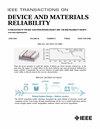Modeling Degradation Kinetics of FAPbI₃ Perovskite Solar Cells: Impact of Microstructural and Optoelectronic Defects
IF 2.3
3区 工程技术
Q2 ENGINEERING, ELECTRICAL & ELECTRONIC
IEEE Transactions on Device and Materials Reliability
Pub Date : 2025-04-10
DOI:10.1109/TDMR.2025.3559531
引用次数: 0
Abstract
The operational thermal stability of perovskite solar cells (PSCs) is a critical issue hindering their commercialization. Therefore, besides achieving high power conversion efficiency (PCE), understanding and quantifying the device degradation kinetics of PSCs is necessary for their reliability and to prevent failure under thermal stress. In this work, exponential and linear degradation models have been adopted to comprehend and quantify the degradation kinetics of FAPbI3 and multifunctional fluorinated molecule 3-fluoro-4-methoxy-4’,4”-bis((4-vinyl benzyl ether) methyl)) triphenylamine (FTPA)-modified FAPbI3 PSCs. Further, various figures of merit, such as acceleration factor, degradation factor, mean lifetime, transformational fraction, and activation energy, have been deduced by fitting the PCE degradation data into the Arrhenius equation and onto the Johnson– Mehl-Avrami (JMA) kinetic models. These figures of merit have been correlated with other defect-determining factors such as micro-strain and Urbach’s energy. The degradation factor and PbI2 residuals are reduced for controlled PSCs to FTPA-modified PSCs. Furthermore, the activation energy and operational thermal stability of FTPA-modified PSCs have increased due to the forming of a hydrogen-bonding polymer network, which enhances PSCs’ thermal stability and acceleration factor. Our findings reveal that the studied devices’ intrinsic stability, thermal stability, and mean lifetime strongly correlate with micro-structural and optoelectronic defects, which helps to improve the performance of photovoltaics.FAPbI₃钙钛矿太阳能电池的降解动力学建模:微观结构和光电子缺陷的影响
钙钛矿太阳能电池(PSCs)的热稳定性是阻碍其商业化的关键问题。因此,除了实现高功率转换效率(PCE)外,了解和量化PSCs的器件降解动力学对于其可靠性和防止在热应力下失效是必要的。本文采用指数和线性降解模型来理解和量化FAPbI3和多功能氟化分子3-氟-4-甲氧基-4′,4”-双((4-乙烯基苄基醚)甲基))三苯胺(FTPA)修饰的FAPbI3 psc的降解动力学。此外,通过将PCE降解数据拟合到Arrhenius方程和Johnson - Mehl-Avrami (JMA)动力学模型中,推导出了加速因子、降解因子、平均寿命、转化分数和活化能等各种性能指标。这些优点的数字与其他缺陷决定因素相关,如微应变和乌尔巴赫能量。受控PSCs的降解因子和PbI2残留量减少到ftpa修饰的PSCs。此外,由于氢键聚合物网络的形成,ftpa修饰的psc的活化能和操作热稳定性增加,从而增强了psc的热稳定性和加速因子。我们的研究结果表明,所研究的器件的固有稳定性、热稳定性和平均寿命与微结构和光电缺陷密切相关,这有助于提高光伏电池的性能。
本文章由计算机程序翻译,如有差异,请以英文原文为准。
求助全文
约1分钟内获得全文
求助全文
来源期刊

IEEE Transactions on Device and Materials Reliability
工程技术-工程:电子与电气
CiteScore
4.80
自引率
5.00%
发文量
71
审稿时长
6-12 weeks
期刊介绍:
The scope of the publication includes, but is not limited to Reliability of: Devices, Materials, Processes, Interfaces, Integrated Microsystems (including MEMS & Sensors), Transistors, Technology (CMOS, BiCMOS, etc.), Integrated Circuits (IC, SSI, MSI, LSI, ULSI, ELSI, etc.), Thin Film Transistor Applications. The measurement and understanding of the reliability of such entities at each phase, from the concept stage through research and development and into manufacturing scale-up, provides the overall database on the reliability of the devices, materials, processes, package and other necessities for the successful introduction of a product to market. This reliability database is the foundation for a quality product, which meets customer expectation. A product so developed has high reliability. High quality will be achieved because product weaknesses will have been found (root cause analysis) and designed out of the final product. This process of ever increasing reliability and quality will result in a superior product. In the end, reliability and quality are not one thing; but in a sense everything, which can be or has to be done to guarantee that the product successfully performs in the field under customer conditions. Our goal is to capture these advances. An additional objective is to focus cross fertilized communication in the state of the art of reliability of electronic materials and devices and provide fundamental understanding of basic phenomena that affect reliability. In addition, the publication is a forum for interdisciplinary studies on reliability. An overall goal is to provide leading edge/state of the art information, which is critically relevant to the creation of reliable products.
 求助内容:
求助内容: 应助结果提醒方式:
应助结果提醒方式:


